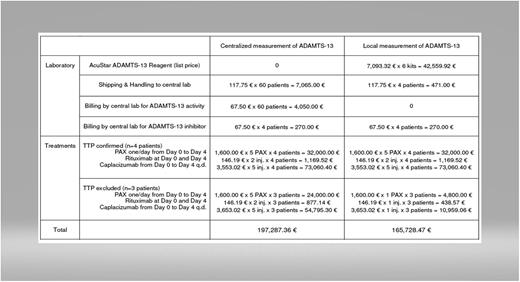Abstract
Background: Thrombotic thrombocytopenic purpura (TTP) is a rare thrombotic microangiopathy (TMA) that can be caused by congenital or acquired severe deficiency of a disintegrin and metalloproteinase with a thrombospondin type 1 motif, member 13 (ADAMTS-13), an enzyme that cleaves von Willebrand factor (VWF). ADAMTS-13 deficiency leads to the accumulation of ultra-large VWF multimers, leading to platelet aggregation and microthrombi formation. Aside clinical symptoms, the diagnosis of TTP is based on laboratory parameters such as thrombocytopenia, hemolytic anemia with the presence of schistocytes, and severely reduced activity of ADAMTS-13 (<10%). As TTP is a life-threatening condition characterized by microvascular thrombosis, it is of great importance to shorten the time to the treatment, and according to the French recommendations, patients with suspected TTP must be treated with the triplet therapy including plasma exchange (PEX), rituximab, and caplacizumab, plus corticosteroids until the results of ADAMTS-13 was obtained. As this therapy must be pursued only in the case of deficiency, a rapid ADAMTS-13 testing is critical for early diagnosis and optimal management of acute TTP.
Design and aims of the study: We first retrospectively compared the performance of a rapid fully automated chemiluminescent assay (HemosIL AcuStar ADAMTS-13) to those of the FRETS-VWF73 assay in the diagnosis of TTP. Then, we compared the cost-effectiveness of a strategy based on the on-site measurement of ADAMTS-13 activity using the AcuStar assay vs. its centralized measurement in a reference laboratory, as it is currently the case at our institution. For that purpose, we created two scenarios based on either the local measurement of ADAMTS-13 activity with a maximum time-to-result of 16 hours (assay performed during daytime, 7/7) or its centralized measurement with a median time-to-result of 4 days (range: 2-8), as demonstrated from the 2018-2021 estimates. The triplet therapy was hypothesized to be started on admission and stopped if ADAMTS-13 activity was >10%. In case of ADAMTS-13 activity <10%, an inhibitor screening would be performed at the reference laboratory, as this assay was not expected to be locally implemented. For the calculation, we considered the costs of reagent, shipping/handling of the samples to the reference laboratory, laboratory staff workload, reimbursement rates, and treatments administered in patients with suspected TTP until availability of the ADAMTS-13 result.
Results: In the plasma from 56 patients with acute TMA, ADAMTS-13 activity was not significantly different when evaluated using the HemosIL AcuStar ADAMTS-13 and the FRETS-VWF73 assays [median=72.6% (range: 0.2-126) vs. 79% (range: 5-150); p=0.08]. The concordance of test results as whether ADAMTS-13 activity was below (n=5) or above the threshold of 10% using the 2 assays was excellent (kappa=1.00), allowing an accurate diagnosis of the 5 patients with confirmed TTP. Based on the local activity between 2018 and 2021, there was a mean of 60 prescriptions of ADAMTS-13 activity per year. Most were for the follow-up of TTP patients and for patients with non-TTP TMA, whereas 7 were for the diagnosis of acute TTP, as suggested by the French score, which was confirmed in 4 cases (mean values). As shown in the Table, the local measurement of ADAMTS-13 activity was found to be cost-effective with a 16%-reduction of the costs compared to its centralized measurement in the 7 patients with suspected TTP during the first 4 days. This equates to 4,508 € saved per patient with suspected acute TTP.
Conclusions: Together with its short turnaround time (33 min) and its full automation, our results suggest that the HemosIL AcuStar ADAMTS-13 activity assay could be an assay of choice to rapidly measure ADAMTS-13 activity in the plasma and thus to establish the diagnosis of acute TTP in emergency settings. Considering the local costs, using the strategy based on the local evaluation of ADAMTS-13 activity led to a 16%-reduction of the overall costs during the first 4 days after admission of the 7 patients with suspected acute TTP. Moreover, by dramatically decreasing the time-to-result (<1 day vs. 4 days), unnecessary potentially harmful and expensive treatments could be withheld earlier in patients in whom the diagnosis of TTP was ruled out based on an ADAMTS-13 activity >10%.
Disclosures
No relevant conflicts of interest to declare.
Author notes
Asterisk with author names denotes non-ASH members.


This feature is available to Subscribers Only
Sign In or Create an Account Close Modal